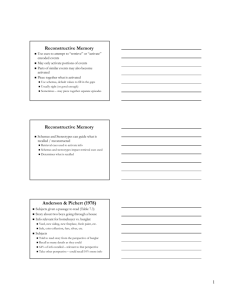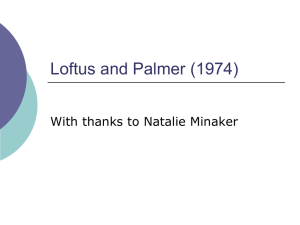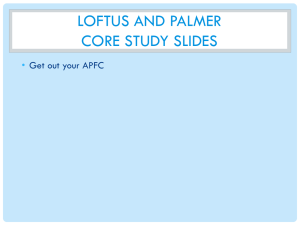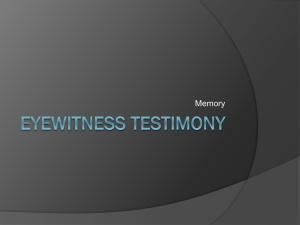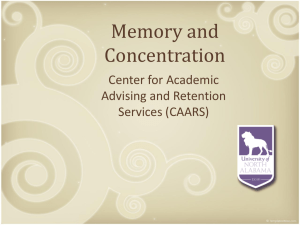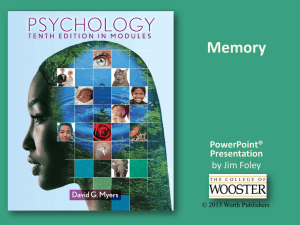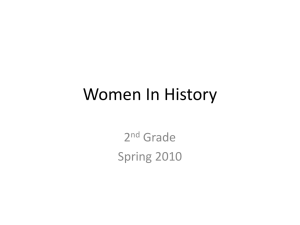4. Memory manipulation - gleneaglesyear12psychology
advertisement
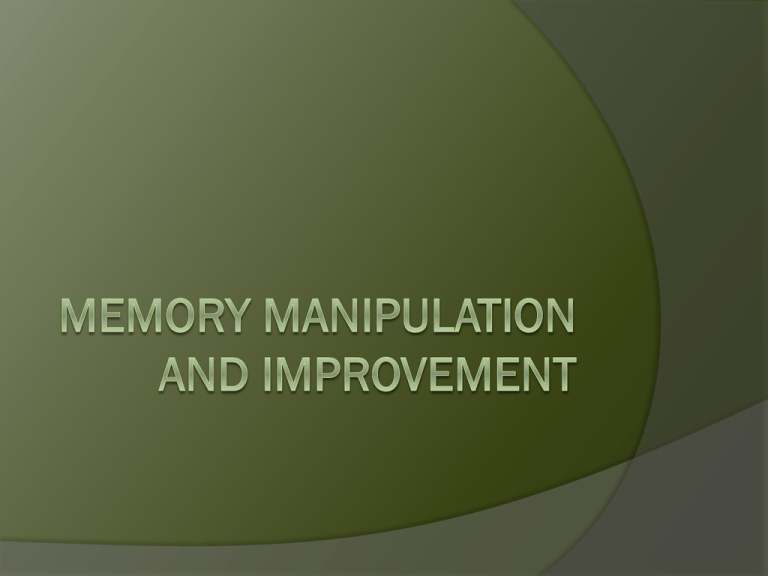
Memory….Accurate Research findings indicate that much of what we recall from LTM is NOT an accurate representation of what actually happened previously. Memory includes some exact details but also some additions that are logically plausible, things that might have happened, filtered and shaped by our thoughts, attitudes and beliefs as well as by who we are as individuals and social beings. Human memory is able to remember relevant fragments of what we experience, but is prone to errors and distortions. Memory….Accurate Unlike a camera or audio recorder that captures a perfect copy of information, the details of human memory can change over time. Without our conscious awareness, details can be added, subtracted, exaggerated or downplayed. Confidence in memory is no guarantee of its accuracy, in fact there is little correlation. Some researchers believe that strong confidence in the memory of minor details may actually be a cue that the memory is inaccurate or even false. (Reisberg, 2007; Hockenbury & Hockenbury, 2006) Why so many errors? Memory is not simply recorded but actively constructed To form a new memory you actively organise and encode different types of information (visual, auditory, tactile etc.) When you later attempt to retrieve this information, you actively reconstruct or re-create the details of your memory. Over time recalling memories can change the content and meaning of a memory Your experience of memory is NOT a guarantee that it reflects reality! Bartlett’s research on manipulation of memory British psychologist Frederick Bartlett in 1932 first drew attention to the reconstructive nature of human memory. Bartlett believed Ebbinghaus studied human memory in an artificial way. E.g. Using nonsense syllables to control influence of past experience excluded important variables that impact on human memory in everyday life such as the influence of our prior experiences, attitudes and expectations. Bartlett’s research on manipulation of memory Participants read prose (story or essay) or looked at a picture. Participants were asked to recall and describe the prose or draw the picture on several later occasions. Each time the original stimulus material was remembered slightly differently. e.g. Unusual or unexpected events were described in a more logical or sensible way (as if to match their personal beliefs of what might likely be true). Bartlett concluded that we tend to remember only a few key details of an experience, and that during recall we reconstruct the memory, drawing on our personal values, beliefs, and expectations to make up and add missing bits in ways that complete the memory in a logical or plausible way. Usually done without conscious awareness of it happening. Loftus’s leading question research Other studies have confirmed Bartlett’s conclusions and extended his findings. U.S. Psychologist Elizabeth Loftus and various colleagues on eyewitness testimony. Loftus found that eyewitnesses similarly reconstruct their memories and their testimony is therefore not always accurate. Many of Loftus’ studies involve showing participants a short film, video or slides of an event such as a car accident and then asking them specific questions about the scene they “witnessed”. Sometimes information that was not present in the actual scene or which contradicts the scene is introduced. At other times, leading questions are asked. Loftus’s leading question research The way questions are asked during eye witness testimony can influence memory Shows how recall does in fact involve an active reconstruction of events, that is open to suggestion Leading Questions – are questions that have content or are phrased in such a way that suggests what the desired answer is or to lead to the desired answer. Example of a “Leading Question” e.g. To a witness of a car accident “How fast was the car going when it ran the stop sign?” This is a leading question according to Loftus (1975) because it contains a preposition (i.e. Information that should or must be true in order for the question to make sense). The question presupposes or assumes there was a stop sign. But what if there was no stop sign? The witness might answer the question anyway because it was a question about how fast the car was going and not a question about the presence of a stop sign or whether the car ran the stop sign. Loftus proposed that the way the question was worded the witness might add the new false information about the stop sign to their memory of the event. Then they would be more likely to recall it as a part of their reconstructed memory when answering a question about it such as “Did you see a stop sign?” at a later time. Loftus’s leading question research – study no. 1 One of Loftus’ research on memory reconstruction was conducted with US colleague John Palmer (1974). Two lab experiments that investigated the influence of question wording on memory and how information supplied after an event can distort a witness’s memory for that event. 45 volunteer uni student participants shown 7 clips of car accidents. Clips were short excerpts from driver education films ranging from 5 to 30 seconds long. Loftus’s leading question research – study no. 1 Participants were asked to write a description of the accident after viewing each clip. Also participants were asked to answer some specific questions about the accident, including a critical question requiring an estimation of speed of the cars involved in each collision. There were 5 conditions in the experiment, with 9 participants randomly assigned to each condition. Each condition had a different verb used to complete the critical question (therefore different versions of the question were asked). Loftus’s leading question research – study no. 1 All participants asked the question – ‘About how fast were the cars going when they________ each other?’ - The gap was filled with Smashed (Condition 1) Collided (Condition 2) Bumped (Condition 3) Hit (Condition 4) Contacted (Condition 5) Loftus’s leading question research – study no. 1 To control the potential influence of the order in which the clips were viewed, the clips were presented in a different order to each group of participants. The most “intense” verbs resulted in the highest speed estimates and the least “intense” in the lowest speed estimates. See table on next slide. Differences in speed estimates were found to be statistically significant at p<0.005. Loftus and Palmer suggested that the different estimates could have been influenced by the verbal label used to characterise the intensity of the car crash. They also suggested that results could have been influenced by response bias e.g. Being uncertain about the exact speed, participants may have adjusted estimates to fit with their expectations of the researcher. Loftus’s leading question research – results study no. 1 Participants estimates of speed were influenced by how the question was asked VERB MEAN SPEED ESTIMATE (MPH) Smashed 40.5 Collided 39.3 Bumped 38.1 Hit 34.0 contacted 31.8 Loftus’s leading question research – study no. 2 150 volunteer uni student participants randomly assigned to 3 groups (conditions) again viewed accident footage – this time a 1 minute film that included a 4 second scene of a multiple car crash. Participants asked ‘About how fast were the cars going when they________ each other?’ - Gap filled with: Hit (Condition 1) Smashed (Condition 2) One group not asked about the speed of the cars (Condition 3) Differences in mean scores of each group were found to statistically significant. Loftus’s leading question research –study no. 2 One week later all participants asked 11 questions about the accidents without viewing the film again. The critical question ‘did you see any broken glass’ was asked to all 3 groups This question was “hidden” among the other questions that served as “distracter” questions and placed in a random position on the participant’s question paper. There was no broken glass in the film Loftus’s leading question research – study no. 2 results Response Verb Mean speed estimate (MPH) Smashed 10.46 Hit 8.00 Verb condition Smashed Hit Control (no verb) Yes 16 7 6 No 34 43 44 Loftus’s leading question research –study no. 2 results Participants ‘recollection’ of seeing glass was influenced by how the original speed question was asked a week earlier. Although most participants accurately reported not seeing any broken glass, more participants who had been given the verb “smashed” (16) reported seeing broken glass than did those who had been given the question with the verb “hit” (7). Loftus’s leading question research –study no. 2 results Loftus and Palmer suggested in the first part participants formed a memory of the car crash they had witnessed after viewing the film. They had integrated their memory of the accident with the new false piece of information added after the event – smashed or hit - which caused some to remember broken glass that wasn’t really there. They had reconstructed a new distorted memory. Suffered source confusion – unable to distinguish real info from false info given after the event. It arises when the true source of the memory is forgotten or when a memory is attributed to the wrong source. Conclusion – memories can be altered by post event exposure to inaccurate info during questioning Other studies Numerous other studies by Loftus and others have since found that the memories of eyewitnesses are reconstructions, instead of exact replicas, of the events witnessed. These studies also confirm Loftus’ findings that eyewitness memories can be altered by post-event exposure to inaccurate information introduced during questioning. See Fig. 8.3 on page 396 “Model of memory” that integrates new information. False Memories Participants shown footage of impossible events Children shown film of meeting bugs bunny at Disneyland which is impossible as bugs is a Warner Brothers brand When questioned later the subjects exposed to the film were more likely to ‘remember’ such an encounter than the control group Read Box 8.1 on page 396 False Memories Participants read stories about them getting lost in the shopping centre as children Told the info comes from relatives About 25% of participants after reading the story report recalling the event Elaboration and organization Elaboration enables effective encoding The more associations that are made between new information and that already in memory the more likely the information will be retrieved Making it meaningful makes it easier to remember Improving memory Observing unusual events (e.g. Teacher on top of the flagpole at school) is often enough to ensure a scene is remembered. But often we must learn information that is more difficult and this requires conscious effort. Mere exposure, even very frequent exposure, to information is often insufficient to produce efficient remembering. Attention must be given to the information, the it must be organised and integrated into the information already stored in LTM. Context and State dependent cues Retrieval can be enhanced if the conditions under which the information was originally learned is recreated – either the external environment (context) or the learner’s internal environment (state). This approach is based on the encoding specificity principle. (Tulving, 1983) Context dependent – environmental cues in a particular setting (context) where a memory was formed that act as retrieval cues to help access the memories formed in that context. E.g. sights, sounds, smells of a specific location. Experiment on context dependent cues Goddon and Baddeley (1975) wanted to compare the efficiency of land training and underwater training of deep sea divers. Divers with a list of 40 unrelated words in either of two settings - on the beach or under about 5 metres of water. Divers then asked to recall words either in the same environment or the alternate one. Results showed divers recalled up to 20% more words when words were learned and retrieved in the same context. Context dependent cues Eyewitnesses taken back to the crime scene to recall apparently forgotten information. The environmental cues at the crime scene act as additional retrieval cues that assist recall of the information. Studies on students taking exams in the same room as work learned showed any differences are sufficiently small so as not to be of concern for students. However, this is only when the learning environment and the testing environment are similar (i.e. Different rooms In the same school) If the testing environment is substantially different from the learning environment, the differences in performance are likely to be more noticeable. State dependent cues State Dependent cues are associated with an individual’s internal physiological and/or psychological state at the time the memory was formed, which act as retrieval cues to help access those memories. Information is more likely to be remembered if the person is in the same state as when they learned it e.g. drunks hiding an object often have difficulty finding it when sober but when drunk again can recall where they hid the object. State dependent cues It seems that aspects of the psychological and physiological state (in the previous case, intoxication) may become encoded with new memories. State dependent retrieval involves better recall of information when the physiological and/or psychological states or learning and retrieval match. This DOES NOT mean that intoxication improves memory – it actually impairs memory as it interferes with encoding. State dependent cues Your mood also provides state-dependent retrieval cues. We seem to associate good or bad events with their accompanying emotional state. The emotional states become retrieval cues when we feel good or bad again, and they trigger memories that are consistent with the mood. However, there is a complicating factor: When happy we recall happy events, but when we feel “down” our minds can become flooded with sad or negative events of the past which in turn darken our interpretations of current events. Mnemonic devices Many mnemonic devices were developed in ancient times. Mnemonic devices are techniques for enhancing or improving memory. They make use of information already stored in LTM. They don’t simplify information, they make it more elaborate. More information is stored, not less. Mnemonic devices The additional information makes the material easier to locate and retrieve because it has enhanced organisation in LTM. Tend to organize new information into a cohesive whole, so that retrieval of part of the information generally assists retrieval of the rest of it. The better the information fits with what we already know, the easier it is to retrieve. Mnemonic devices Each mnemonic device is based on a particular kind of elaboration, encoding or rehearsal strategy to enhance memory. Some mnemonic devices emphasise logical organisation, others rely on the use of visual imagery to elaborate the information. Mnemonic devices ACRONYMS Acronyms are pronounceable words formed from the first letters of a sequence of words. e.g. ANZAC, EFTPOS, WHO, NATO Acronyms can be used for remembering other types of information. e.g. Roy G Biv (red, orange, yellow, green, blue, indigo, violet) – colors of rainbow or visual spectrum Mnemonic devices RHYMES A rhyme is a phrase or a string of words (such as a jingle) often with an emphasis on similar sounding key words. e.g. “i” before “e” except after “c” They organise information by associating the information with a particular rhythm (sound) and with rhyming words. We know an error in retrieval has occurred when the rhyme is ruined or the rhythm broken. Mnemonic devices Acrostics Acrostics, or the first letter technique involve making verbal associations for items to be remembered by constructing phrases or sentences using the first letters of the information to be remembered. e.g. “Every Good Boy Deserves Fruit” to denote the lines on a treble staff in music. - E, G, B, D, F. Acrostics are useful when you have to remember the information in sequential order. Mnemonic devices PEG-WORD METHOD The peg-word method consists of memorising a rhyme or jingle that has mental “pegs” or “markers” on which you “hang” the items to be remembered. Very effective for a list of information to be remembered in a particular sequence. E.g. Shopping items, errands, historical events. Mnemonic devices 1 – Bun 2 – Shoe 3 – Tree 4 – Door 5 – Hive The rhyming words are the retrieval cues (the “peg” words), then you must associate the information to be remembered with the rhyme by using visualisation. Visualisation is particularly effective when the image of the peg-word object and the image of the object to be recalled interact rather than merely being paired side by side. The peg-word method has been shown through experimental evidence to significantly improve recall of information from semantic LTM. Mnemonic devices NARRATIVE CHAINING Narrative chaining involves linking otherwise unrelated items to one another (“chaining”) to form a meaningful sequence or story (“narrative”). See Table 8.3 on page 405 Narrative chaining research – Bower and Clark, 1969 Given a word list to learn Experimental group – told to use narrative chain Control group – given no instructions on memory techniques Results narrative chaining group recalled 93% of words Control group recalled on average 13% Narrative chaining research – Bower and Clark, 1969 The sample was good The variables were clearly defined Extraneous variables were controlled (research design) The results good – experimental group performed significantly differently to the control group Ah but how do we know this difference is a real one…. Not just some random event? NOW BRACE YOURSELF FOR SOME STATISTICS! Research on narrative chaining Participants who used narrative chaining remembered 6 times more information than participants who learned by simply repeating the words to themselves. (Loftus, 1980) Narrative chaining adds organisation and meaningfulness to otherwise meaningless material. Particularly useful when needing to remember information in a particular order. Research has found that it is a useful technique for people with memory impairment as well as people with normally functioning memory. (Wilson, 1995) A narrative will not help though, if it hangs together so loosely that you cannot remember the story (Matlin, 2002) Method of Loci The Method of Loci uses a well-learned sequence of locations as a series of retrieval cues for the information to be recalled. Particularly useful when needing to remember a list of items in a particular order. Mentally “move” through the locations sequentially without difficulty. Involves a mental image of the items to be remembered and visually linking them with a particular location. Method of Loci If any item is an abstract or unusual concept that is hard to visualise, it must be changed into an object that can be visualised instead. E.g. Justice = courtroom The method of loci elaborates information to be learned by linking it with memory cues that are very familiar. Experimental findings indicate that it can improve memory by a factor of 2 to 3 times over serial recall without the use of a mnemonic device. Key-word method KEY-WORD METHOD A mnemonic device for learning LOTE that involves visual imagery as a way of encoding information to improve retrieval. e.g. Spanish word for “horse” is “caballo” pronounced “cab-eye-yo”. “Eye” could be chosen as the key word to help remember, then a horse with a very large eye could be visualised. CRAMMING TO STUDY Massed rehearsal – a couple of extended study sessions over a very short period of time Spaced or distributed rehearsal – spacing out study sessions over an extended period of time. Research suggests that if long-term retention of information is required, spaced rehearsal is a more effective strategy. Read Box 8.6 on page 411 about effective studying using the SQ3R method.
